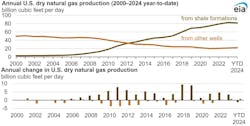Tayvis Dunnahoe
Exploration Editor
Writing about oil and gas, and exploration specifically, can make for interesting listening at venues away from the industry. Oil prices have been low for a time, but with each jump in price, natural resources become a wider topic of discussion.
A few months ago, I was talking with a small group of acquaintances, none of whom were industry folks, when the conversation turned to the topic of oil, namely the price and a general query of what my thinking was on the state of the industry.
Having taken off my editor's cap, I offered a light description of the week's most recent analysis. At some point, one member of the group suggesed that oil prices may always rise because "they aren't making any more dinosaurs."
"Technically, there are no dinosaurs in oil," I responded.
I followed this with the higher points of sedimentary functions and explained how microorganisms, sea plankton, and plant life were buried over millions of years.
"Combine these carbon-rich deposits with extreme heat and pressure from subsequent burial, and the Earth's subsurface becomes a 'kitchen' that 'cooks' these layers of sediments into oil and natural gas."
Raising questions
I spirited into a personal topic of interest: how a new understanding of plate tectonics has helped open presalt plays on both sides of the Atlantic in recent years along the coasts of South America and West Africa.
It wasn't long before the small gathering gravitated to their phones to see what was new in social media. Given the group's rapid dispersion, plate tectonics wasn't a crowd-pleaser in the normal sense of the term.
Casual conversation often raises questions without the requirement of an in-depth answer. For a slight variation on the term, a first lesson provided to OGJ editors is, "never raise more questions than you've answered."
News stories often come with high stakes. A typo can ruin a perfectly good lead sentence, and an omitted word can induce skepticism for even the soundest piece of analysis. Despite the risks, an editor trudges the narrow path between superlative language, unclear jargon, pertinent facts, and redundancies from previous coverage. Putting out news can come together quickly or can be an uphill climb. No two stories are alike and assigning the right facts for each news item is a delicate balance.
With too little information, a reader is left wondering. Providing too much information can lead the reader to boredom. And once a story is on record, the readers are in control. Content marketing dictates that readers engage, but for an editor it is more meaningful to know that readers learned something new (as editors often do). At a minimum, readers should leave a story with some piece of information that can be applied to further their own analysis.
Being fast is important. Turning an 8 a.m. press release into an 8:30 a.m. story with a headline has its value. But the second lesson for an OGJ editor: writing a story correctly from an informed perspective is sometimes more important than publishing first. Quick is still good but holding a story to add more facts improves the analysis. Analysis after all, is half the job. The internet is a wonderful tool that offers an infinite space to run with information, but economy of words takes thought. Adding, expounding context, and then "cutting the darlings" is a process. Underlying the news is the background information by which an editor filters the facts they use to develop their stories for an informed readership.
Finding answers
It's true, there are no dinosaurs in oil. But reflecting on my OGJ-inspired response to a casual comment reminded me that many times, stories are written as answers to questions that haven't been asked. Journally speaking, analysis outweighs timeliness. And while specialized knowledge can sometimes be lost on a general audience, it's well worth the research and analysis that goes behind an in-depth perspective.


